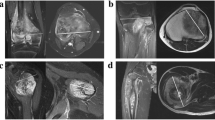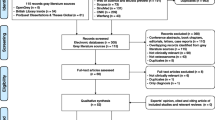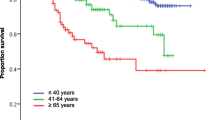Abstract
Introduction
In this retrospective study, we assessed tumor growth patterns as visualized on MR images, and examined whether tumor growth patterns correlate with clinicopathologic variables. In addition, we also evaluated the relationship between patient outcome and tumor growth pattern in the whole study cohort and in subsets of AJCC IIA and IIB patients.
Materials and methods
We retrospectively reviewed 347 patients with Enneking stage IIB and AJCC stage II osteosarcoma that was treated with surgery and neoadjuvant chemotherapy at our institute. Patients were divided into three groups based on tumor growth pattern, namely, concentric, eccentric, and longitudinal groups. Fisher’s exact test was performed to analyze correlations between tumor growth patterns and clinicopathological variables. Five-year metastasis-free survival and overall survival were evaluated using univariate and multivariate analyses.
Results
In terms of tumor growth patterns, 225 patients (64.8%) had a concentric, 71 (20.5%) an eccentric and 51 (14.7%) a longitudinal tumor. Eccentric tumors were usually small and responded well to chemotherapy, whereas concentric tumors were large and responded poorly. The prognostic significances of tumor growth patterns were confirmed by univariate and multivariate analyses. Among AJCC stage IIA patients, no survival difference was found according to growth pattern, whereas in AJCC stage IIB patients, longitudinal tumors were associated with significantly better survival than concentric tumors.
Conclusions
Tumor growth pattern was found to be an independent prognostic factor in stage II osteosarcoma. Moreover, longitudinally growing tumors were associated with better survival in AJCC stage IIB patients. Our results suggest that tumor growth pattern could be used as an indicator of risk-adapted therapy when combined with other prognostic factors.



Similar content being viewed by others
References
Enneking WF, Spanier SS, Goodman MA (1980) A system for the surgical staging of musculoskeletal sarcoma. Clin Orthop Relat Res 153:106–120
Greene FL, Page DL, Flemming FD (2002) American joint committee on cancer: cancer staging manual. Springer, New York
Kim MS, Cho WH, Song WS, Lee SY, Jeon DG (2007) Time dependency of prognostic factors in patients with stage II osteosarcomas. Clin Orthop Relat Res 463:157–165
Rosen G, Marcove RC, Huvos AG, Caparros BI, Lane JM, Nirenberg A et al (1983) Primary osteogenic sarcoma: eight-year experience with adjuvant chemotherapy. J Cancer Res Clin Oncol 106(Suppl):55–67. doi:10.1007/BF00625054
Onikul E, Fletcher BD, Parham DM, Chen G (1996) Accuracy of MR imaging for estimating intraosseous extent of osteosarcoma. AJR Am J Roentgenol 167(5):1211–1215
Edmonson JH, Green SJ, Ivins JC, Gilchrist GS, Creagan ET, Pritchard DJ et al (1984) A controlled pilot study of high-dose methotrexate as postsurgical adjuvant treatment for primary osteosarcoma. J Clin Oncol 2(3):152–156
Taylor WF, Ivins JC, Unni KK, Beabout JW, Golenzer HJ, Black LE (1989) Prognostic variables in osteosarcoma: a multi-institutional study. J Natl Cancer Inst 81(1):21–30. doi:10.1093/jnci/81.1.21
Spanier SS, Shuster JJ, Vander Griend RA (1990) The effect of local extent of the tumor on prognosis in osteosarcoma. J Bone Joint Surg Am 72(5):643–653
Petrilli AS, Gentil FC, Epelman S, Lopes LF, Bianchi A, Lopes A et al (1991) Increased survival, limb preservation, and prognostic factors for osteosarcoma. Cancer 68(4):733–737. doi:10.1002/1097-0142(19910815)68:4<733::AID-CNCR2820680412>3.0.CO;2-0
Heck RK Jr, Stacy GS, Flaherty MJ, Montag AG, Peabody TD, Simon MA (2003) A comparison study of staging systems for bone sarcomas. Clin Orthop Relat Res 415:64–71. doi:10.1097/01.blo.0000093898.12372.6c
Kim MS, Lee SY, Cho WH, Song WS, Koh JS, Lee JA et al (2008) Tumor necrosis rate adjusted by tumor volume change is a better predictor of survival of localized osteosarcoma patients. Ann Surg Oncol 15(3):906–914. doi:10.1245/s10434-007-9779-8
Lee JA, Kim MS, Kim DH, Lim JS, Yoo JY, Koh JS et al (2008) Relative tumor burden predicts metastasis-free survival in pediatric osteosarcoma. Pediatr Blood Cancer 50(2):195–200. doi:10.1002/pbc.21446
Sumner DR, Galante JO (1992) Determinants of stress shielding: design versus materials versus interface. Clin Orthop Relat Res 274:202–212
van der Woude HJ, Bloem JL, Hogendoorn PC (1998) Preoperative evaluation and monitoring chemotherapy in patients with high-grade osteogenic and Ewing’s sarcoma: review of current imaging modalities. Skeletal Radiol 27(2):57–71. doi:10.1007/s002560050339
Lawrence JA, Babyn PS, Chan HS, Thorner PS, Pron GE, Krajbich IJ (1993) Extremity osteosarcoma in childhood: prognostic value of radiologic imaging. Radiology 189(1):43–47
Bieling P, Rehan N, Winkler P, Helmke K, Maas R, Fuchs N et al (1996) Tumor size and prognosis in aggressively treated osteosarcoma. J Clin Oncol 14(3):848–858
Jeon DG, Kim MS, Cho WH, Song WS, Lee SY (2007) Clinical outcome of osteosarcoma with primary total femoral resection. Clin Orthop Relat Res 457:176–182
Ellman H, Gold RH, Mirra JM (1974) Roentgenographically “benign” but rapidly lethal diaphyseal osteosarcoma; a case report. J Bone Joint Surg Am 56(6):1267–1269
Haworth JM, Watt I, Park WM, Roylance J (1981) Diaphyseal osteosarcoma. Br J Radiol 54(647):932–938
Nathan SS, DiResta GR, Casas-Ganem JE, Hoang BH, Sowers R, Yang R et al (2005) Elevated physiologic tumor pressure promotes proliferation and chemosensitivity in human osteosarcoma. Clin Cancer Res 11(6):2389–2397. doi:10.1158/1078-0432.CCR-04-2048
Conflict of interest statement
Each author certifies that he has no commercial associations (e.g., consultancies, stock ownership, equity interest, patent/licensing arrangements, etc.) that might pose a conflict of interest in connection with the submitted article.
Author information
Authors and Affiliations
Corresponding author
Additional information
Each author certifies that his institution has approved or waived approval for the human protocol for their investigation, and that all investigations conformed to the ethical principles of research.
Rights and permissions
About this article
Cite this article
Kim, M.S., Lee, SY., Cho, W.H. et al. Growth patterns of osteosarcoma predict patient survival. Arch Orthop Trauma Surg 129, 1189–1196 (2009). https://doi.org/10.1007/s00402-008-0714-7
Received:
Published:
Issue Date:
DOI: https://doi.org/10.1007/s00402-008-0714-7




